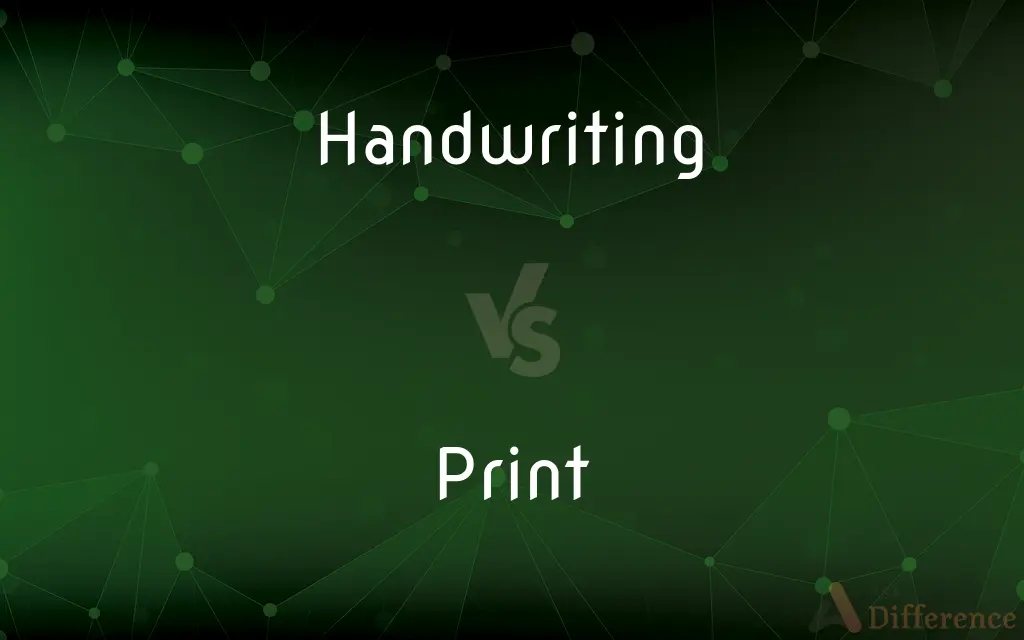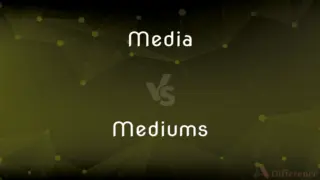Handwriting vs. Print — What's the Difference?
By Tayyaba Rehman & Urooj Arif — Updated on April 3, 2024
Handwriting refers to the individual, handwritten style of writing characters, while print denotes text produced mechanically or digitally in a standardized form.

Difference Between Handwriting and Print
Table of Contents
ADVERTISEMENT
Key Differences
Handwriting is a personal form of writing by hand, where each individual's style can vary significantly, reflecting their unique characteristics and nuances. Print, on the other hand, refers to text created through mechanical or digital means, offering uniformity and standardization across documents. This distinction is crucial in understanding the applications and implications of each form of writing.
While handwriting is often prized for its personal touch and is used in informal contexts or where individuality is valued, such as in personal letters or notes, print is preferred for formal documents, books, and any medium requiring clarity and uniformity. The move towards digital communication has further emphasized the predominance of print in professional and academic settings.
The legibility of handwriting can vary greatly from person to person, with some handwriting being easy to read and others more difficult, depending on the writer's style and neatness. Print, due to its standardized nature, generally offers high legibility, which is why it is used for most published materials.
In educational settings, handwriting plays a critical role in early learning, helping children develop fine motor skills and learn the alphabet. However, as students progress, the emphasis shifts towards typing and digital literacy, reflecting the importance of print in contemporary communication.
The choice between handwriting and print often depends on the context and the message's purpose. Handwriting can convey intimacy and personality, making it suitable for personal communication. Print, being more impersonal but highly legible and efficient, is suited for formal, official, and mass-produced documents.
ADVERTISEMENT
Comparison Chart
Definition
Individual style of writing by hand
Text produced mechanically or digitally
Uniqueness
Unique to each individual
Standardized and uniform
Legibility
Varies greatly
Generally high
Use
Personal notes, informal communication
Formal documents, books, mass communication
Emotional Value
Can convey personal touch and intimacy
More impersonal but efficient
Technological Influence
Less influenced by technology, more traditional
Heavily influenced by modern printing and digital technologies
Compare with Definitions
Handwriting
Used in personal and informal contexts.
The handwritten notes in the book added a personal touch.
Offers clarity and uniformity in text.
The print version of the document was impeccably clear and easy to read.
Handwriting
Reflects individual personality and style.
Her handwriting was as elegant and meticulous as her personality.
Reflects the impact of digital technology on communication.
Digital print technologies have revolutionized how we disseminate information.
Handwriting
Important for early educational development.
Children learn to express themselves through their unique handwriting.
Facilitates mass communication and distribution.
Print media, such as newspapers and magazines, reach a wide audience.
Handwriting
Varies in legibility and neatness.
Despite his efforts, his handwriting remained difficult to decipher.
Less personal but more efficient for conveying information.
Email, in print form, is the standard for professional and academic communication.
Handwriting
Can convey a sense of intimacy and authenticity.
Handwritten letters carry an emotional weight that digital messages lack.
Essential for formal documentation and publication.
Legal documents are always in print to ensure legibility and standardization.
Handwriting
Handwriting is the writing done with a writing instrument, such as a pen or pencil, in the hand. Handwriting includes both printing and cursive styles and is separate from formal calligraphy or typeface.
Reproduce by printing
Handwriting
Writing with a pen or pencil
This method of duplicating can reproduce typewriting, handwriting, or drawings
Produce (books, newspapers, etc.), especially in large quantities, by a mechanical process involving the transfer of text or designs to paper
A thousand copies of the book were printed
Handwriting
Writing done with the hand.
Write (text) clearly without joining the letters together
Print your name and address on the back of the cheque
Handwriting
The writing characteristic of a particular person.
Mark (a surface, typically a fabric or garment) with a coloured design or pattern
A delicate fabric printed with roses
Handwriting
The act or process of writing done with the hand, rather than typed or word-processed.
The text appearing in a book, newspaper, or other printed publication, especially with reference to its size, form, or style
Bold print
She forced herself to concentrate on the tiny print
Handwriting
Text that was written by hand.
An indentation or mark made on a surface or soft substance
There were paw prints everywhere
Handwriting
The characteristic writing of a particular person.
A picture or design printed from a block or plate or copied from a painting by photography
The walls were hung with sporting prints
Handwriting
(by extension) A characteristic trait or hallmark by which somebody may be recognised.
A piece of fabric or clothing with a coloured pattern or design printed on it
Light summer prints
A floral print dress
Handwriting
Present participle of handwrite
A mark or impression made in or on a surface by pressure
The print of footsteps in the sand.
Handwriting
The cast or form of writing peculiar to each hand or person; chirography.
A fingerprint.
Handwriting
That which is written by hand; manuscript.
A device or implement, such as a stamp, die, or seal, used to press markings onto or into a surface
Fancy letters made by hand-carved prints.
Handwriting
Something written by hand;
She recognized his handwriting
His hand was illegible
Something formed or marked by such a device.
Handwriting
The activity of writing by hand;
Handwriting can be slow and painful for one with arthritis
Text, lettering, or other marks produced in ink from type as by a printing press or from digital fonts by an electronic printer
Needed glasses to read the print.
Printed state or form
A short story that never got into print.
A printed publication or edition of a text; a printing
The first print of that book has sold out.
A design or picture transferred from an engraved plate, wood block, lithographic stone, or other medium
Had prints of flowers hanging on the walls.
A photographic image transferred to paper or a similar surface.
A copy of a movie made on film or in a high resolution digital format, as for public exhibition.
A fabric or garment with a dyed pattern that has been pressed onto it, usually by engraved rollers.
The pattern itself
A blouse with a paisley print.
To press (a mark or design, for example) onto or into a surface
Tracks that were printed in the snow.
To make an impression on or in (a surface) with a device such as a stamp, seal, or die.
To press (something, such as a stamp) onto or into a surface to leave a marking.
To produce by means of pressed type, an electronic printer, or similar means, on a paper surface
Printed more copies of the ad.
To offer in printed form; publish
The publisher collected the essays and printed them as a book.
To reproduce (a digital document or image) on a paper surface
Printed the email.
To convert (a digital document) into a file format designed for publication.
To write (something) in characters similar to those commonly used in print.
To impress firmly in the mind or memory
An experience that will be printed in our hearts forever.
To produce a photographic image from (a negative, for example) by passing light through film onto a photosensitive surface, especially sensitized paper.
To produce (an electronic component) by mechanically transferring a circuit or circuit pattern onto a nonconductive surface.
To fabricate (an object) by means of a 3D printer.
To work as a printer.
To produce something in printed form by means of a printing press or other reproduction process.
To write characters similar to those commonly used in print.
To produce or receive an impression, marking, or image
The negative printed poorly.
Published or reproduced by printing, especially in contrast to electronic publication
A print newsletter.
Relating to or involved in media based on printing, especially newspapers and magazines
A print journalist.
Of, relating to, or writing for printed publications.
A print edition of a book
(transitive) To produce one or more copies of a text or image on a surface, especially by machine; often used with out or off: print out, print off.
Print the draft double-spaced so we can mark changes between the lines.
To produce a microchip (an integrated circuit) in a process resembling the printing of an image.
The circuitry is printed onto the semiconductor surface.
(ambitransitive) To write very clearly, especially, to write without connecting the letters as in cursive.
Print your name here and sign below.
I'm only in grade 2, so I only know how to print.
(ambitransitive) To publish in a book, newspaper, etc.
How could they print an unfounded rumour like that?
(transitive) To stamp or impress (something) with coloured figures or patterns.
To print calico
(transitive) To fix or impress, as a stamp, mark, character, idea, etc., into or upon something.
(transitive) To stamp something in or upon; to make an impression or mark upon by pressure, or as by pressure.
To display a string on the terminal.
To produce an observable value.
On March 16, 2020, the S&P printed at 2,386.13, one of the worst drops in history.
(transitive) To fingerprint (a person).
(uncountable) Books and other material created by printing presses, considered collectively or as a medium.
Three citations are required for each meaning, including one in print.
TV and the Internet haven't killed print.
(uncountable) Clear handwriting, especially, writing without connected letters as in cursive.
Write in print using block letters.
(uncountable) The letters forming the text of a document.
The print is too small for me to read.
(countable) A newspaper.
A visible impression on a surface.
Using a crayon, the girl made a print of the leaf under the page.
A fingerprint.
Did the police find any prints at the scene?
A footprint.
(visual art) A picture that was created in multiple copies by printing.
(photography) A photograph that has been printed onto paper from the negative.
(film) A copy of a film that can be projected.
Cloth that has had a pattern of dye printed onto it.
(architecture) A plaster cast in bas relief.
To fix or impress, as a stamp, mark, character, idea, etc., into or upon something.
A look will print a thought that never may remove.
Upon his breastplate he beholds a dint,Which in that field young Edward's sword did print.
Perhaps some footsteps printed in the clay.
To stamp something in or upon; to make an impression or mark upon by pressure, or as by pressure.
Forth on his fiery steed betimes he rode,That scarcely prints the turf on which he trod.
To strike off an impression or impressions of, from type, or from stereotype, electrotype, or engraved plates, or the like; in a wider sense, to do the typesetting, presswork, etc., of (a book or other publication); as, to print books, newspapers, pictures; to print an edition of a book.
To stamp or impress with colored figures or patterns; as, to print calico.
To take (a copy, a positive picture, etc.), from a negative, a transparent drawing, or the like, by the action of light upon a sensitized surface.
To use or practice the art of typography; to take impressions of letters, figures, or electrotypes, engraved plates, or the like.
To publish a book or an article.
From the moment he prints, he must except to hear no more truth.
A mark made by impression; a line, character, figure, or indentation, made by the pressure of one thing on another; as, the print of teeth or nails in flesh; the print of the foot in sand or snow.
Where print of human feet was never seen.
A stamp or die for molding or impressing an ornamental design upon an object; as, a butter print.
That which receives an impression, as from a stamp or mold; as, a print of butter.
Printed letters; the impression taken from type, as to excellence, form, size, etc.; as, small print; large print; this line is in print.
That which is produced by printing.
A core print. See under Core.
The result of the printing process;
I want to see it in black and white
A picture or design printed from an engraving
A visible indication made on a surface;
Some previous reader had covered the pages with dozens of marks
Paw prints were everywhere
A copy of a movie on film (especially a particular version of it)
A fabric with a dyed pattern pressed onto it (usually by engraved rollers)
A printed picture produced from a photographic negative
Put into print;
The newspaper published the news of the royal couple's divorce
These news should not be printed
Write as if with print; not cursive
Make into a print;
Print the negative
Common Curiosities
When is print preferred over handwriting?
Print is preferred for formal documents, professional communication, and publications requiring clarity and uniformity.
How has technology affected the use of handwriting and print?
Technology has favored the use of print through digital communication platforms, reducing the prevalence of handwriting in professional settings.
Can handwriting be as legible as print?
While some individuals have very legible handwriting, print generally offers higher and more consistent legibility.
Can the style of handwriting reveal personality traits?
Some believe handwriting can reflect certain personality traits, though this is subjective and not universally accepted.
What is the main difference between handwriting and print?
The main difference lies in their production; handwriting is manually produced and unique, while print is mechanically or digitally generated and standardized.
Why is handwriting important?
Handwriting is crucial for personal expression and early educational development, enhancing fine motor skills and literacy.
How do cultural perceptions of handwriting and print differ?
Cultural perceptions vary, with handwriting often associated with tradition and personal touch, while print is seen as modern and efficient.
Is there a trend towards digital handwriting?
Yes, devices like tablets and digital pens combine the personal touch of handwriting with the convenience of digital editing and sharing.
Is handwriting becoming obsolete?
While its use has declined in professional settings, handwriting remains valuable for personal expression and specific educational purposes.
Why do educational systems teach both handwriting and typing?
Teaching both skills ensures that students can express themselves in personal and formal contexts and navigate digital environments.
Share Your Discovery

Previous Comparison
Media vs. Mediums
Next Comparison
Though vs. HoweverAuthor Spotlight
Written by
Tayyaba RehmanTayyaba Rehman is a distinguished writer, currently serving as a primary contributor to askdifference.com. As a researcher in semantics and etymology, Tayyaba's passion for the complexity of languages and their distinctions has found a perfect home on the platform. Tayyaba delves into the intricacies of language, distinguishing between commonly confused words and phrases, thereby providing clarity for readers worldwide.
Co-written by
Urooj ArifUrooj is a skilled content writer at Ask Difference, known for her exceptional ability to simplify complex topics into engaging and informative content. With a passion for research and a flair for clear, concise writing, she consistently delivers articles that resonate with our diverse audience.














































